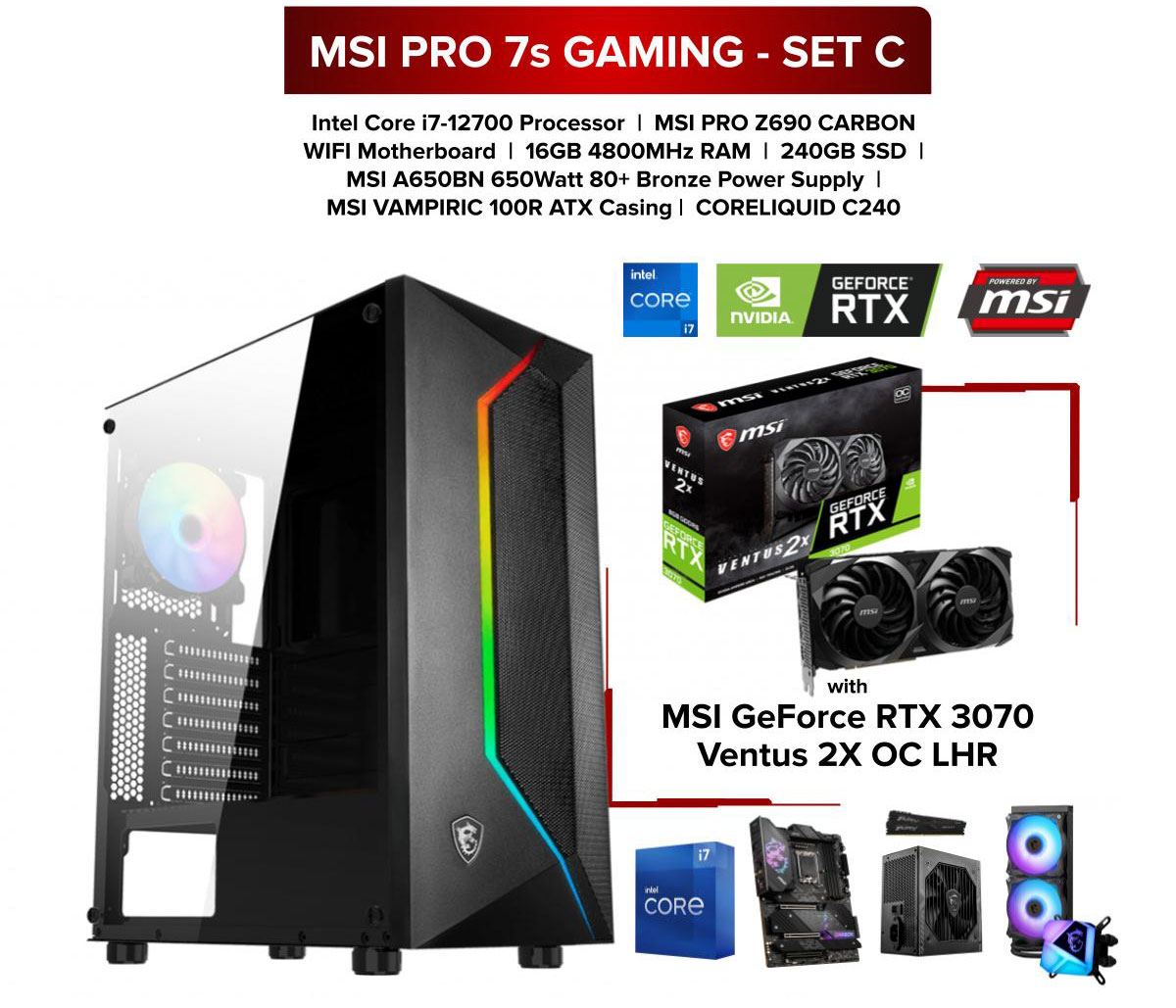Can you believe it’s still June but you’re already experiencing summer level temperatures? Alas, spring comes and goes, but don’t let your guard down because your computer is still experiencing heat dissipation issues. After years of development, desktop CPUs have jumped from 4-cores to 8, 10, and to 16. Combining 5GHz frequency, having 200W+ TDP power consumption is quite common for current CPUs, giving users who emphasize performance quite a headache.

MAG CORELIQUID 240R V2 WHITE
Between the two types of CPU coolers, air coolers and liquid coolers, the latter seems more popular due to better performance. The truth is, there is no significant performance difference between the two options. Your choice depends on your needs. Here are some tips and differences between the two for your reference.

Air cooling is simple. It works by transferring the heat absorbed from the bottom to the heat sink, blowing off the heat with fans. Therefore, an air cooler can only be effective with a good heat-absorbing base typically made of pure copper due to its optimal heat absorption and thermal conductivity.

The air cooler’s base is usually designed with a single piece of pure copper, but some use Heat Pipe Direct Touch (HPDT), which was quite popular from 2007 to 2012. According to the statement at that time, the contact area between the base and the heat pipe was not perfect due to the limitations of manufacturing process, so there would be a certain loss of heat dissipation capacity. Allowing the heat pipe to directly make contact with the upper cover of the CPU can reduce that loss. This concept was very popular at the time, and many air-cooler brands have launched products with similar concepts.
However, after some time, people started to notice the disadvantages of making direct contact with the heat pipe. The heat pipe itself is designed to be like a vacuum, and the thickness of the pipe is limited. There are 2 main problems with the heat pipe at this time. First, the heat pipe must be flattened to fit the CPU. This treatment will lower its strength, and the heat pipe may be deformed after a long time, which will lead to poor contact between the CPU and the radiator, reducing the heat dissipation performance. Second, the surface area of the CPU is different, and the location of the heat source is not exactly the same. Some CPUs with a large surface area can be completely covered by the base, but the heat pipe may not touch the heat source of the smaller CPUs. In contrast, there is no such problem with bases made of pure copper, so most of the current mid-to-high-end air coolers are changed back to having pure copper bases.

After the base completes absorbing the heat, the heat energy is then transferred to the fins through the pure copper heat pipe. The heat conduction efficiency here is affected by many things, such as the contact method between the heat sink and the heat pipe, including through the FIN, buckle on the FIN and reflow soldering. It is generally considered that reflow soldering is the best, but it depends on the actual craftsmanship.
Next is the design of heat pipes. The number and thickness of heat pipes are almost the basic standards for measuring thermal conductivity. Generally, there are 6 heat pipes for medium tier coolers, and 7~8 for high-end ones. The more heat pipes there are the better the thermal conductivity there is. It also depends on the bending method and distribution of the heat pipe.

The final step in air cooling is to dissipate heat, using the fan to blow off the heat accumulated on the heat sink. The fan’s performance is related to the fan blade’s design and speed. Some fans pursue quietness, while having low speed and weak wind force, while others focus on wind pressure, emphasizing that the entire radiator can be blown through from the front, and have air suction added on the back if necessary. The fan helps remove heat from the cooling fins, thereby lowering the CPU temperature.
For air coolers to be effective the heat dissipation area must be large. This is why many mid-to-high-end air coolers are large, single towers, or have 14cm fans with double towers. However, air coolers seem to have reached the peak of development space. The main reason is that the radiator area is limited by the width of the PC case, the size of motherboard PWM heat sink, size of the memory, and size of the graphics card. How to best maximize performance in a limited space will be the research direction of major air cooler brands in the future.

MEG CORELIQUID S360
The liquid cooler is also called an all in one liquid cooler because it is filled with a special liquid coolant. The working principle of liquid cooling is not much different from that of air cooling. It transfers the heat generated by the CPU from the top cover to the inside of the block head through the copper base and the water pipes.

The liquid coolant transfers the heat of the CPU to the radiator through the water pipes, and the fan blows off the heat of the radiator. The biggest advantage of liquid coolers is that the liquid coolant has a larger heat capacity. With the design of a large heat dissipation area, it can achieve better heat dissipation than air coolers.
Generally speaking, the thermal conductivity of liquid coolant is about 4 times that of air, and the flow of liquid coolant can quickly transfer heat. The problem of air cooler’s heat dissipation area has been mentioned above. With the use of 240mm, 280mm and 360mm sized liquid coolers, the area that can be used for heat exchange is larger than that of air coolers, and they are not limited by space so the heat dissipation effect is much better. Of course, if the liquid cooler has a 120mm radiator, its performance won’t be as good as the performance of a mid-level air cooler.

As mentioned above, air and liquid coolers have their own pros and cons. The strength of the air cooler is its durability. It can be used for a long period of time. However, the shortcomings of air cooler is the large space it occupies, potentially blocking memory, and it is difficult to remove the graphics card and M.2. The heat dissipation performance isn’t as good as that of liquid cooler too. You might wonder, which one is better, AIO or custom liquid cooler? In fact, although these two are both liquid coolers, they are designed for different people with different purposes. Let’s talk about the differences between the two.
As discussed previously, the working principle of liquid cooling is to solve the problem of CPU heat dissipation through the flow of liquid coolant. Due to the larger heat capacity of liquid coolant, as long as the liquid coolant can cool down in time, it can provide excellent heat dissipation performance. As for the principle of AIO and custom liquid cooler, the principle is basically the same with the main difference being the architecture.
Air cooler is back thanks to the heat pipes

The argument that liquid cooler will completely replace air cooler has existed for many years. Because of the increasing performance and core of the CPUs, it has been difficult for air coolers to suppress these increasingly powerful processors. The earlier strategy was to use pure copper on the radiator. It is known that the thermal conductivity of copper is much better than that of aluminum, so the pure copper radiator + large fan was the mainstream design at that time, but what comes with pure copper is the bigger weight.

But soon with heat pipe technology making improvements, the performance of air coolers was greatly improved. The principle of the heat transfer pipe is that the liquid coolant at the heating end evaporates when it is heated and goes to the condensation end. After being cooled down, it changes back to liquid form and flows back to the heating end, repeating the cycle. The efficiency of the heat pipe is so high that most of the better radiators on the market use the heat pipe, while the heat dissipation performance is also related (but not absolute) to the number of heat pipes.
In the era of 4-core processors being most common, the operating frequency is generally below 3GHz, and overclocking is not very high, so the power consumption and heat generation are not too high. Air coolers with heat pipe technology can handle this just fine. Therefore, the mainstream market hasn’t seen the value of liquid coolers yet. However, in recent years, with performance requirements, CPU cores, and CPU frequency all increasing, liquid coolers became highly valued.
Custom liquid cooler

After talking about the market development and changes in air coolers and liquid cooler, let’s go back to the topic of AIO and open loop liquid coolers. Open loop liquid cooler, as the name suggests, have separate and independent parts so users need to assemble by themselves. The most important components are water block, reservoir, pump, radiator, fans, fittings, tubes, and coolant. Note that some reservoir and pump are combined. Various brands of open loop liquid cooler all have the components packaged together for installation and use. Of course, some users may choose the components on their own and assemble them by themselves. In addition to the reservoir, pump, water block, and radiator, they also need to buy a water valve, a connection head, a water flow meter, an extension head, an exhaust valve, a drain valve, and a thermometer.

When these components are connected, a water pipe rack and some other accessories are required to prevent the water pipes from falling off and leaking. Before use, liquid coolant should be injected into the liquid-cooling system. Exhaust and a series of operation checks should be performed as well. After all, once the open loop liquid cooler is used and there is an external leak, the motherboard, graphics card and even M.2 hard drives are at risk.
Flexible tube and hard tube

Open loop liquid coolers has two types of pipes: soft and hard pipe. Soft pipe is generally made of PVC, PU and other materials. The advantage is that it is more flexible and bendable. The hard pipes are normally made of PETG, acrylic and other materials. The hard pipes need its layout to be planned in advance with the corresponding corners purchased. The hard tube looks better and can be matched with various peripheral accessories, such as water flow meters and water tanks. However, the installation is more troublesome and is usually done by professional. Soft pipes are easier to use so most people can install it.
All-in-one Liquid Cooling
After introducing the open loop liquid cooler, let’s talk about the AIO liquid cooler. Around 2011, the first generation of AIO liquid coolers began to appear on the market. The modular design of the block head and the radiator simplifies the installation process. After more than ten years of development, today’s AIO liquid cooler has become very mature, and the integrated water pump solution has become mainstream. Users only need to install the fan on the radiator, and then install it onto the PC case. The biggest advantage of AIO liquid cooler is that it is easy to install and does not require complicated procedures.
AIO liquid cooler has two common water pump designs. One is like the MAG CORELIQUID C360/P360, with the water cooling pump fixed on the water channel of the radiator. Space and performance will be affected more or less but this design can keep the vibration of the operation away from the block head, reducing the chance of liquid leakage, and allowing the block head to be made thinner.

Another design of the AIO liquid cooler is to have the water pump integrated into the water blockhead. Liquid coolers manufactured by Asetek follow this design. Because the pump is not designed on the radiator, it can maximize the space and provide a better cooling effect.
In addition, to give liquid coolers more functions besides heat dissipation, the new generation of liquid coolers are mostly designed with unique ARGB lighting effects or other configurations such as LCD screens.
The MEG CORELIQUID S360 in the picture above is an example. The water block has a 2.4-inch IPS panel display, which can be used to display information such as CPU frequency, temperature, and GIF. In addition, the water block is also equipped with a 6cm fan, which can blow away the excess heat on the heat sink in the PWM power supply area and help the motherboard cool down.
Summary – Performance or Convenience

The advantage of open loop liquid cooler is that the system’s water path is long, which means there is more liquid coolant and better cooling capacity. The diameter can even reach 14mm or more. With a high-speed pump, the heat can be quickly taken away from the CPU. Some water blocks can even be customized. For example, the MPG Z690 CARBON EK X motherboard in the picture above has oversized distribution plate that help spread the heat with the help of liquid coolant. Due to the size of the AIO liquid cooler, the output of the pump, the capacity of the water cooling liquid, and the smaller circulation system, AIO liquid cooler’s performance is not as strong as that of open loop liquid cooler.
The strength of AIO liquid cooler is convenience. It can be used as long as the fan is fixed with screws and the motherboard is fixed with a bracket. At most, a few fans and ARGB cables need to be connected. Although the performance is not comparable to that of open loop liquid cooler’s, it is still more than enough than that of most air cooler.
A combo of the perfect Motherboard and icy-cool Liquid Cooler providing you the utmost white and premium feel
Suggested liquid cooler
Suggested Motherboard to paired with cooler
Battle-duo combo to stay cool during every gameplay
Suggested liquid cooler
Suggested Motherboard to paired with cooler

Suggested PC MSI PRO 7 GAMING PC [POWERED by MSI]
- • INTEL CORE I7-12700 PROCESSOR
- • MSI PRO Z690-A WIFI DDR4 MOTHERBOARD
- • 8GB 4800MHZ RAM – 2PCS
- • 240GB M.2 SSD
- • MSI A650BN 650W 80+ BRONZE POWER SUPPLY
- • MSI MAG VAMPIRIC 100R ATX CASING
- • MSI MAG CORELIQUID C240
- • MSI GEFORCE RTX 3070 VENTUS 2X OC 8GB DDR6 GRAPHIC CARD




